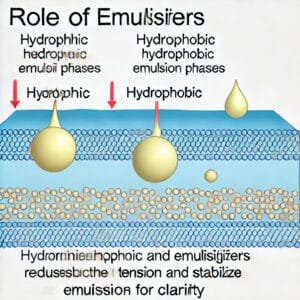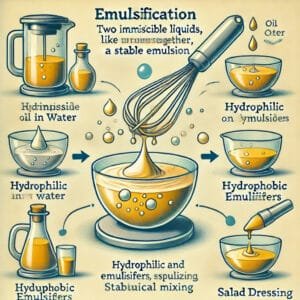Small Overview of Emulsification Process
Emulsification is an interesting process that happens when two or more immiscible liquids, like oil and water, are brought together to form an even stable mixture called an emulsion. This process is not only important for food related situations, but it also has wide applications in several industries. No matter how you look at it, whether you are having a sandwich anointed with creamy mayonnaise or using cosmetic creams which comprise oil and water, emulsification is at play making textures and flavors that make our daily lives better. Emulsification, isn’t that wondrous? From salad dressings prepared in the kitchen to the make-up we wear, emulsification resonates in many fields of life. It’s time to focus on those topics more closely.

Definition and Importance
What is Emulsification?

Emulsification can be defined as the mechanical process of dispersing or otherwise mixing two immiscible liquids in such a way as to achieve a dispersed (stable) system. Emulsification is accomplished by the addition of emulsifiers, these are materials which help decrease the interfacial tension between the two liquids at the interface making enables the two liquids to interact.
Why is it Important?
For one, emulsification is a concept that every skilled chef must grasp given that it forms the basis of most if not all techniques of cooking. In the kitchen, this emulsion mix enables the preparation of sauces and dressings among other meals like desserts with an even texture.
In the cosmetic, pharmaceutical, and even paint industries, emulsification is very important to the procedures used in product formulation. If emulsification were to be eliminated from these products, they would be rendered unstable and of minimal use.
Types of Emulsions
Oil-in-Water Emulsions
Oil in water emulsions are those sporadic mixtures in which there are small oil droplets within water, as dispersed in this category. This type of emulsion is found in Vinaigrette, mayonnaise, or even in many products containing dairy. It is the oil droplet phase that is dispersed in a water continuous phase.
Water-in-Oil Emulsions
On the other hand, water in oil (W/O) emulsion occurs when water droplets are dispersed into a continuous oil phase. This kind is quite rare, except in butter and certain types of creams. For these emulsions, water is the dispersed phase surrounded by oil, which imparts a rich creamy feeling.
Understanding the Science of Emulsification
Function of Emulsifiers
What Emulsifying agents do
Emulsifiers are crucial elements in emulsification. The two types of properties are present in them. They are hydrophilic which means they are attracted to water and hydrophobic which pushes them away from the water. This escaping action causes some blisters around the two liquid surfaces, reducing the barrier effect.
Some Common Emulsifiers Used
Some common emulsifying agents are egg yolk, mustard, and lecithin. Such emulsifiers each have special characteristics that make them effective.
For example, protein in egg yolks acts as a stabilizer in the emulsifying agent mayonnaise, whereas lecithin, one of the soy components, is widely used in produced food products.
Stability and Factors Affecting Emulsions
Temperature
Temperature is one of the crucial parameters that looks into the stability of emulsions. Emulsions can tend to break under high temperatures as there is a lot of energy which enables the droplets to coalesce. On the contrary, low temperatures can be beneficial in the stability of emulsions, but probably affects the texture or the taste of the end product.
Mechanical Action
Mechanical action, for example, whisking or blending, is also fundamental in the formation and retention of emulsions within the product. The mechanical stress ruptures the droplets, assisting in the formation of smaller droplet sizes, thereby allowing for more even mixing. In the absence of enough mechanical stress, emulsions can be very prone to separation.
Practical Applications of Emulsification

Everyday Examples
Mayonnaise
Mayonnaise is one of the most common emulsions and therefore, understandable, is an emulsion of mayo and oil. When ethyl alcohol is added and vinegar, oil particles are dispersed in a viscous continuous phase of egg yolk vinegar and oil. The emulsifying mechanism results in a thickening process, more than improving the product taste.
Salad Dressings
Every other day figure which is also common is the salad dressings, mainly made of vinaigrette. These basic mixtures tend to break very fast, however, certain additives like emulsions and mustard can be included that allow better integration of the concentrated mixture, thus improving the overall quality.
Industrial Uses
Cosmetics
In contrast, emulsification is not just restricted to the kitchen. In the realm of cosmetic formulation, emulsions are the building blocks for the creation of creams, lotions and more. These emulsions enable getting an even coating and optimal absorption of the active ingredients.
Pharmaceutical products
Pharmaceutical products also utilize the emulsification principle in the development of stable medication formulations. Some drugs can be encapsulated in emulsions to enhance their efficacy in the treatment of patients.
Emulsification in Action: Recipes
Homemade Mayonnaise
First, look for ingredients that allow you to create a recipe for homemade mayonnaise.
- 1 large egg yolk
- 1 tablespoon Dijon mustard
- 1 tablespoon white wine vinegar
- 1 cup vegetable oil
- Salt to taste
Step-by-Step Instructions
In a mixing bowl, combine first the egg yolk, mustard and vinegar and mix as much as possible. Then you have to add slowly the vegetable oil drop by drop while whisking the mixture continuously. This is very important for forming the emulsion. When the emulsion gets more vicious, you may add the oil faster. When all the oil gets in, then add salt as per your taste.
Simple Vinaigrette
Ingredients Needed
- 3 tablespoons olive oil
- 1 tablespoon balsamic vinegar
- 1 teaspoon Dijon mustard
- Salt and pepper to taste
Step-by-Step Instructions
In a small bowl, combine the balsamic vinegar with the mustard and whisk the ingredients. While vigorously whisking, pour the olive oil in a thin stream to form an emulsion, with the vinegar and mustard. Add seasoning to the mixture and season again.
Conclusion
In brief, what is emulsification and its importance is what the presented articles examine in order to look at its application in the soy food and industry. It is true that emulsification improves many experiences in our life, from the creamy texture of mayonnaise to the consistency of cosmetic creams. In fact, I recommend you to try your hand at emulsifying in cooking – prepare something self-made such as mayonnaise or a stable vinaigrette! Acceptance of emulsification increases not only one’s culinary expertise but also one’s wisdom in relation to the food science. This means that emulsification is not only a cooking method: it is a basic procedure that affects many of the areas of our lives.
